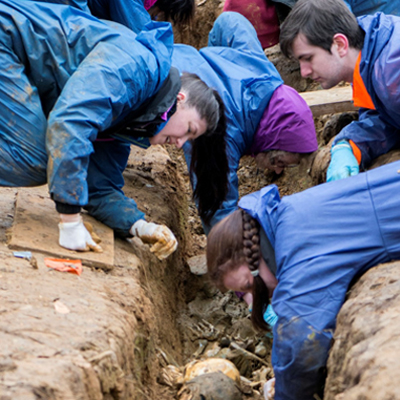“It’s a case of ‘know your enemy’”: Experts from Cranfield University and the National Museum of the Royal Navy work with ZSL to breed a colony of deathwatch beetles, helping HMS Victory address its 90-year-old woodworm problem
A pioneering project at HMS Victory led by experts from Cranfield University is uncovering a wealth of new information about the behaviour of deathwatch beetles, which have been plaguing Lord Nelson’s favourite warship since they were first identified within her timbers in 1932.
The work is taking place as part of The Big Repair - the ten-year, £45m restoration project designed to repair and preserve HMS Victory - the world’s oldest naval ship still in commission - for future generations.
Cathryn Harvey, whose PhD study is focussed on the impact of deathwatch beetle larvae on HMS Victory, was given one of the ship’s timbers which showed evidence of deathwatch beetle activity. Using laser scanning and photogrammetry technology for surface investigation and specialist microCT non-destructive imaging to look inside, she has created fascinating 3D images of the timber, and uncovered evidence of the damage caused by the beetles.
Working with Dr Jenny Kidd from Cardiff University, this data has been used to create prototype displays and activities to help visitors to HMS Victory understand the importance of pest control, and the impact of wood-boring beetles within historic wooden structures.
In addition, Cathryn is part of a team establishing a colony of beetles at London Zoo within timber samples from HMS Victory, where she and other scientists will be able to study their behaviour to learn more about the best way to treat them. The colony is growing at the moment and once established, will be on display to the public later this year.
Cathryn Harvey said: “Standard methods of detecting deathwatch beetles simply aren’t working - you can trap the adults but it’s the larvae that bore the holes in the timbers and cause the problems. Our specialist scanning has revealed the paths of tunnels that the larvae have created; by mapping these we’re starting to understand more about their behaviours and patterns, giving us a better grasp of how, why and where they create such devastating damage. Getting a better picture of this will help conservation teams deal with them more effectively - it’s a case of ‘knowing your enemy’”.
Jenna Taylor, principal conservator and Diana Davis, head of conservation at the National Museum of the Royal Navy, are working with the Cranfield University team on the project. Jenna Taylor said, “We’re in a great position to be doing this work as part of the Big Repair project, what we’re learning here will help heritage sites around the UK and beyond. The work is also helping our visitors to understand that a historic site like HMS Victory isn’t just about a single moment in history, like the Battle of Trafalgar. In fact, she can show us so many fascinating layers of history and science, which are all being uncovered during The Big Repair.”
Deathwatch beetles are one of nearly 400,000 different species of beetles. Over many centuries, the resourceful creatures have made their way from their natural woodland habitat into the timbers of often historic buildings. Cathryn continued: “The species thrives within a temperate climate and only fly when the temperature reaches 18 degrees Celsius, and so in light of climate change the problem is only going to get worse. For example, 100 years ago there were no recorded infestations in Scotland, but it’s a very different picture today. We need to study them more in order to find new ways to deal with the damage they cause.”
The project is part of a wider collaboration between Cranfield University and the National Museum of the Royal Navy led by Dr Fiona Brock, Reader in Analytical and Archaeological Science. Working together for several years, Cranfield’s expertise in heritage science using the latest analytical techniques and forensic knowledge is helping National Museum of the Royal Navy conservators preserve this important part of the UK’s cultural heritage.
